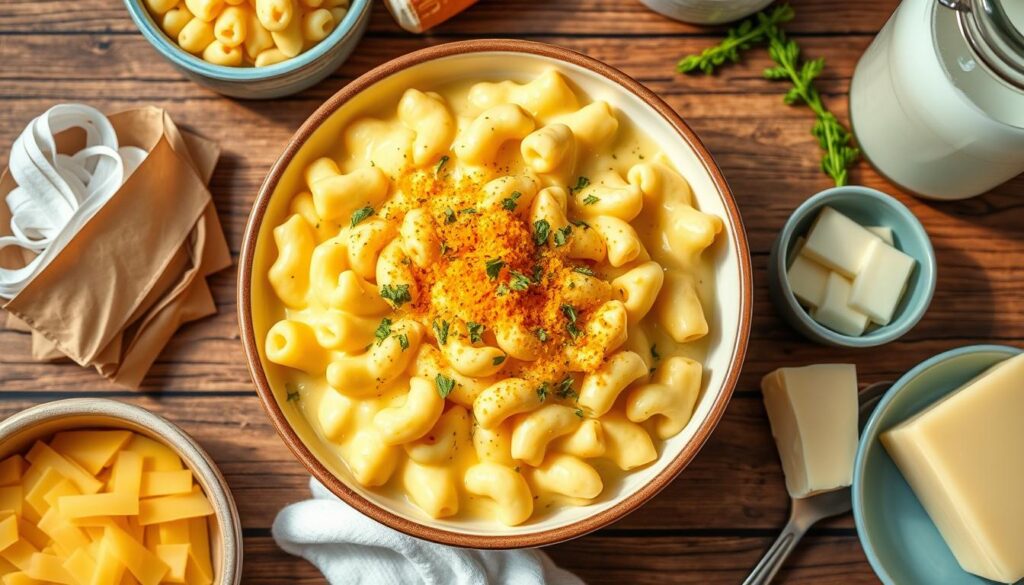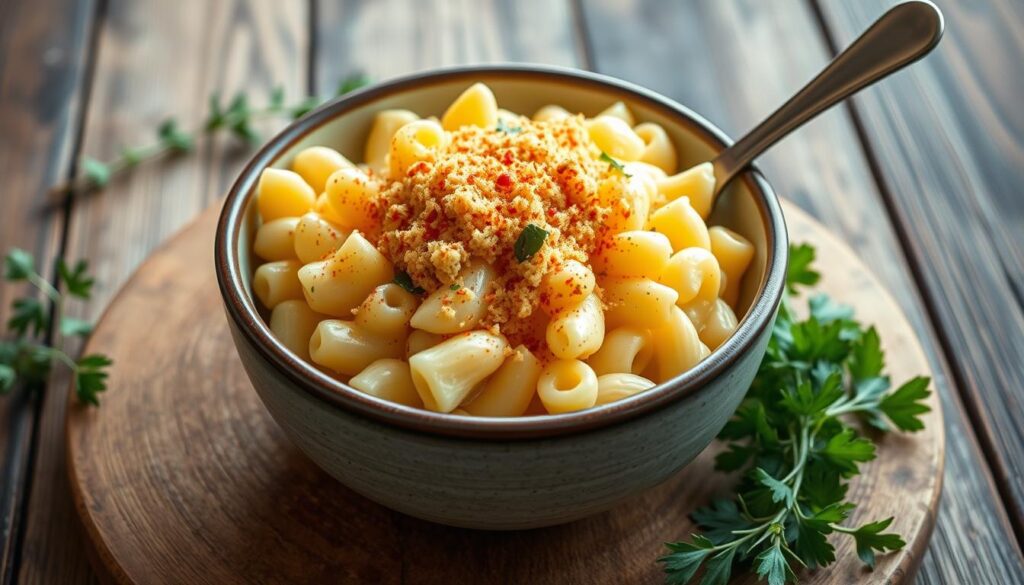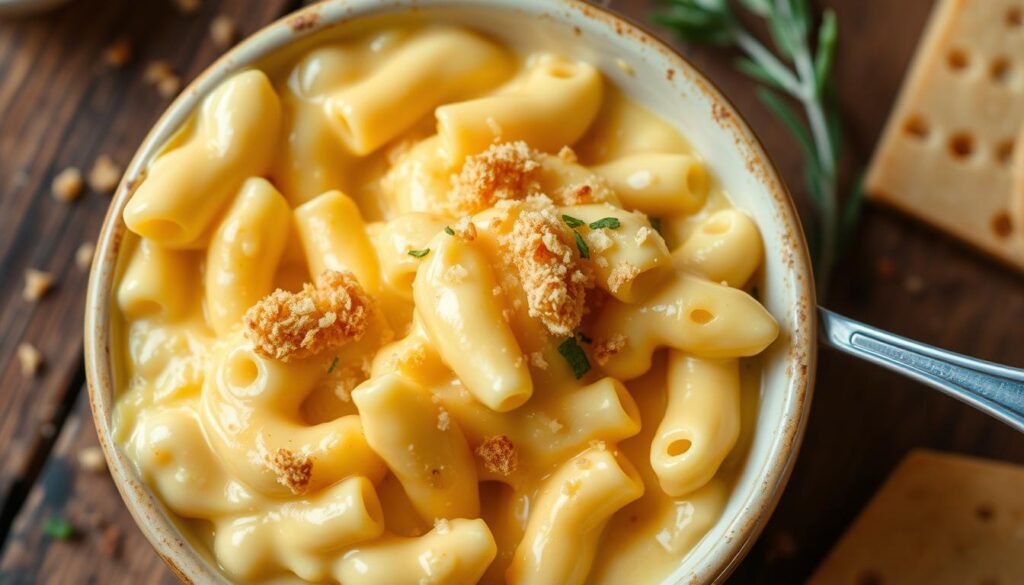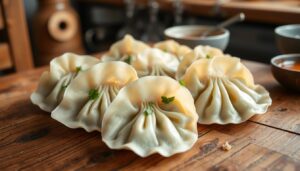
Are you tired of mac and cheese that lacks flavor and texture? Imagine making a gluten-free mac and cheese recipe that’s as good as any restaurant dish.
Comfort food doesn’t have to be a compromise. Your homemade gluten-free mac and cheese can be creamy and cheesy. It will satisfy every craving.
Forget about store-bought options that are shallow. This recipe will change how you make gluten-free mac and cheese. It ensures a dish that’s mouth-watering for everyone.
Table of Contents
Key Takeaways
- Create a restaurant-quality gluten-free mac and cheese at home
- Control ingredients for better taste and nutrition
- Customize your recipe with various cheese and topping options
- Suitable for multiple dietary restrictions
- Cost-effective alternative to pre-made meals
Why Homemade Gluten-Free Mac and Cheese is Better Than Store-Bought
Making your own mac and cheese is more than just cooking. It’s a smart move for those looking for a tasty gluten-free meal. By making an easy mac and cheese recipe at home, you get flavors and control that store-bought can’t offer.

Cost-Effective Benefits
Homemade mac and cheese can save you money. Store-bought gluten-free pasta meals are pricey. But making your own lets you:
- Purchase ingredients in bulk
- Control portion sizes
- Minimize packaging waste
- Save money per serving
Superior Taste and Texture
Gluten-free pasta can be challenging, but homemade recipes let you fine-tune your dish. Research shows that different gluten-free pasta types need unique cooking methods. Stirring frequently and checking pasta before the estimated cooking time helps avoid mushy or gummy textures.
“Freshly grated cheese makes all the difference in creating a creamy, delectable mac and cheese experience.” – Culinary Expert
Control Over Ingredients
When you make your own gluten-free mac and cheese, you choose what goes into it. This means:
- Avoiding unnecessary additives
- Selecting high-quality cheese
- Customizing nutritional content
- Accommodating dietary restrictions
By picking an easy mac and cheese recipe and making it yourself, you get a more delicious, healthier, and personalized meal.
Essential Ingredients for Perfect Gluten-Free Mac and Cheese Recipe

Starting a gluten-free mac and cheese journey means picking the right ingredients. You’ll need components that promise great taste and texture. This is the first step to a delicious plant-based mac and cheese.
Here are the key ingredients for a tasty gluten-free pasta dish:
- 6 oz gluten-free elbow pasta (Rummo brand recommended)
- 1 cup freshly shredded sharp cheddar cheese
- 2-1/4 cups milk (any variety)
- 60g unsalted butter
- 1 teaspoon salt
- Optional: Pinch of cayenne pepper
For a dairy-free cheese sauce, keep these tips in mind:
- Use evaporated milk to remove 60% moisture and quicken thickening
- Experiment with dehydrated cheddar cheese powder for intense flavor
- Adjust sauce consistency by adding reserved pasta water
“The secret to great gluten-free mac and cheese is balancing texture and flavor” – Gluten-Free Cooking Expert
If you’re looking for dairy-free options, consider these:
- Almond milk
- Coconut milk
- Plant-based cheese alternatives
- Nutritional yeast for cheesy flavor
The quality of your gluten-free pasta and cheese sauce is crucial. Choose wisely to make a creamy, satisfying dish that everyone will enjoy.
Choosing the Right Gluten-Free Pasta Brands
Finding gluten-free pasta can be tough, but it’s doable. You’ll find tasty options that meet your pasta needs. Look for pasta that tastes good, feels right, and is healthy.
Top Recommended Gluten-Free Pasta Brands
Some gluten-free pasta brands really stand out. They offer great nutrition:
- Banza: Chickpea pasta with 11g protein per serving
- ZENB: Yellow pea pasta featuring 12g protein and 7g fiber
- Taste Republic: Fusilli with 6g protein and 3g fiber
- Capello’s: Almond flour ravioli providing 16g protein
What to Look for in Gluten-Free Pasta
When picking gluten-free pasta, keep these points in mind:
- Protein content
- Fiber quantity
- Ingredient quality
- Texture similarity to traditional pasta
Avoiding Common Pasta Pitfalls
Cooking gluten-free pasta needs care. Follow the package’s cooking tips and check it often. This prevents it from becoming too soft. A taste test of 21 gluten-free pastas showed big differences in quality.
Pro tip: Different gluten-free pasta brands have varying tastes, scoring from 1.5 to 9 out of 10.
| Pasta Brand | Protein (g) | Fiber (g) | Base Ingredient |
|---|---|---|---|
| Banza | 11 | 5 | Chickpea |
| ZENB | 12 | 7 | Yellow Pea |
| Rice Pasta | 4 | 0 | Brown Rice |
Choosing the right gluten-free pasta can make your mac and cheese amazing!
Mastering the Three-Cheese Blend

Creating the perfect cheese sauce starts with a great cheese blend. Your gluten-free mac and cheese will stand out with a mix of cheeses that offer rich, complex flavors.
When making your cheese blend, keep these tips in mind:
- Use freshly grated cheddar cheese for optimal melting
- Incorporate parmesan cheese for depth and sharpness
- Experiment with unique cheese varieties like Gruyère or smoked Gouda
Professional chefs say to avoid pre-shredded cheeses. They often have anti-caking agents that stop them from melting smoothly. Instead, grate your own cheese for a creamy texture.
“The secret to extraordinary mac and cheese lies in the quality of your cheese blend.” – Culinary Experts
For a top-notch gluten-free mac and cheese, aim for a mix of flavors. A blend of sharp white cheddar, nutty Gruyère, and tangy parmesan cheese makes it sophisticated. It takes the classic comfort dish to a new level.
Pro tip: Let your cheeses get to room temperature before adding them to the cheese sauce. This helps them blend smoothly and prevents clumps.
Step-by-Step Cooking Instructions
Making the perfect gluten-free mac and cheese is all about detail and technique. Whether you’re making it on the stovetop or baking it, these steps will guide you. You’ll create a dish that everyone will enjoy.
Preparing the Pasta
Choose a top-notch gluten-free pasta. Jovial brown rice pasta or Barilla gluten-free elbow pasta are great choices. Cook it al dente to avoid mushiness:
- Boil water with a pinch of salt
- Add 16 oz of gluten-free elbow macaroni
- Cook for 8-10 minutes
- Drain and set aside
Creating the Cheese Sauce
The secret to creamy gluten-free mac and cheese is the sauce. Here’s how to make a perfect bechamel base:
- Melt ½ cup butter in a large skillet
- Add ½ cup cornstarch to create a roux
- Gradually whisk in 4 cups whole milk
- Incorporate cheese blend:
- 8 oz extra sharp cheddar
- 8 oz sharp cheddar
- 8 oz Velveeta
Combining and Baking
For a delightful baked mac and cheese, follow these final steps:
- Preheat oven to 325°F
- Mix cooked pasta with cheese sauce
- Transfer to a baking dish
- Top with additional cheese
- Bake for 15-20 minutes until golden
Pro tip: Optional seasonings like mustard powder or garlic powder can elevate the flavor of your gluten-free mac and cheese.
“A perfectly creamy mac and cheese is all about technique and quality ingredients!” – Gluten-Free Cooking Expert
| Nutrition Facts | Per Serving |
|---|---|
| Calories | 311 kcal |
| Protein | 6g |
| Carbohydrates | 51g |
| Fat | 9g |
Tips for Achieving the Perfect Creamy Texture
Making the ultimate creamy mac and cheese needs some skill in the kitchen. The secret to a smooth cheese sauce is knowing a few key techniques. These techniques make your gluten-free dish go from good to amazing.
First, learn how to make a gluten-free roux. It’s the base of your cheese sauce. This method helps you create a creamy mac and cheese that will wow pasta fans. Here are some important tips for your sauce:
- Grate your cheese at room temperature for smoother melting
- Add cheese gradually to prevent clumping
- Stir constantly to maintain a silky texture
- Use low, steady heat to prevent sauce separation
“The key to a perfect cheese sauce is patience and technique.” – Professional Chef
Choosing the right liquid is key for that dreamy texture. Try using evaporated milk for a richer feel. If your sauce gets too thick, add a little milk to get it just right.
Don’t worry if it takes a few tries to get it right. With each attempt, you’ll get better at making that perfect cheese sauce.
Customization Options and Add-ins
Make your gluten-free mac and cheese your own with fun variations. Try new ingredients to match your taste and health goals. This way, you can enjoy a classic comfort food in a new way.
Protein Power-Ups
Add protein to your mac and cheese for a fuller meal. Here are some tasty protein choices:
- Diced grilled chicken breast
- Crispy bacon bits
- Flaked tuna
- Diced ham
- Crumbled plant-based meat alternatives
Vegetable Mix-Ins
Make your mac and cheese healthier with colorful veggies. They add flavor and nutrients:
- Roasted broccoli florets
- Sautéed spinach
- Steamed cauliflower
- Sweet green peas
- Caramelized onions
Gluten-Free Topping Variations
Get a crunchy topping with these gluten-free options. Try crispy roasted cauliflower crumbs or these:
- Crushed gluten-free crackers
- Toasted almond slivers
- Extra shredded cheese for a golden-brown crust
- Nutritional yeast for a nutty flavor
- Herb-infused gluten-free breadcrumbs
“Creativity in the kitchen transforms a simple dish into a culinary adventure.”
Remember, the best mac and cheese is the one you make your own. Try different combinations to find your favorite gluten-free mac and cheese. It should taste great and fit your diet.
Storage and Reheating Guidelines
Keeping your gluten-free mac and cheese fresh is key. Store leftovers in an airtight container in the fridge for 3-4 days. This way, you can enjoy it again and again.
There are several ways to reheat your mac and cheese:
- Microwave Method: Heat in 30-60 second bursts, stirring each time
- Oven Technique: Preheat to 350°F, cover with foil to keep it moist
- Stovetop Option: Heat slowly, adding milk to keep it creamy
Freezing is also an option, but be careful. You can freeze mac and cheese for 2-3 months. Freezing before baking helps keep it fresh.
“The key to perfect reheated mac and cheese is moisture and gentle heating.”
To reheat mac and cheese well, add a bit of milk or cream. This helps it stay creamy. If frozen, thaw it in the fridge overnight before reheating.
Quick Storage Tips
- Cool mac and cheese completely before storing
- Use shallow, airtight containers
- Label with the date of preparation
- Consume refrigerated leftovers within 3-4 days
Proper storage and reheating are crucial for leftovers. Follow these tips to enjoy your gluten-free mac and cheese as if it were freshly made.
Conclusion
Making the perfect gluten-free mac and cheese needs practice, creativity, and passion. Your homemade recipe can turn a classic dish into a healthy comfort food that everyone loves. By learning about ingredient swaps and cooking skills, you’ll make a mac and cheese that’s just as good as the traditional kind.
This gluten-free way of making mac and cheese is very flexible. You can use rice pasta, chickpea pasta, or zucchini noodles to make it fit your diet. Each serving has 16g of protein and only 480 calories, making it a great choice for those who care about their health.
Getting your recipe just right takes time. Since January 2018, people have been working on their mac and cheese, trying new things, and finding ways to make it even better. Your cooking journey is about finding new flavors, balancing nutrition, and making meals that make everyone happy.
Keep exploring gluten-free cooking by trying new things, learning, and sharing your mac and cheese recipes. Your kitchen is a place to create, and every recipe is a chance to make something special that’s good for you.
F.A.Q
What brands of gluten-free pasta work best for mac and cheese?
Jovial, Barilla, and Rummo are top picks. They hold their shape well and feel like regular pasta. Always follow the cooking instructions and avoid overcooking to prevent mushiness.
How can I make my mac and cheese creamy without using dairy?
Use cashew cheese sauce, nutritional yeast, or plant-based milk for a creamy sauce. Choose dairy-free cheese and make a roux with gluten-free flour for a smooth texture.
Can I make mac and cheese ahead of time?
Yes, you can make it ahead. Store it in an airtight container in the fridge for 3-4 days. Reheat with a splash of milk to keep it creamy.
What cheese blend works best for mac and cheese?
A three-cheese blend is ideal. Try sharp cheddar, parmesan, and Velveeta. Freshly grated cheese is best. You can also try smoked gouda, gruyere, or fontina for different tastes.
How can I add more nutrition to my mac and cheese?
Add protein like grilled chicken, tuna, ham, or bacon. Mix in veggies like broccoli, cauliflower, or spinach. Top with gluten-free breadcrumbs for extra nutrition.
Is it possible to freeze gluten-free mac and cheese?
Freezing is possible but may change the texture. Freeze before baking and thaw in the fridge. Avoid freezing dairy-free versions. Best consumed within 1-2 months.
What can I use instead of wheat flour to make the cheese sauce?
Use cornstarch, arrowroot powder, or gluten-free flour blends like rice flour. These thicken the sauce without gluten.
How do I prevent my gluten-free pasta from becoming mushy?
Follow cooking instructions carefully and check for doneness often. Slightly undercook the pasta before adding it to the sauce. This way, it will cook a bit more when mixed.



